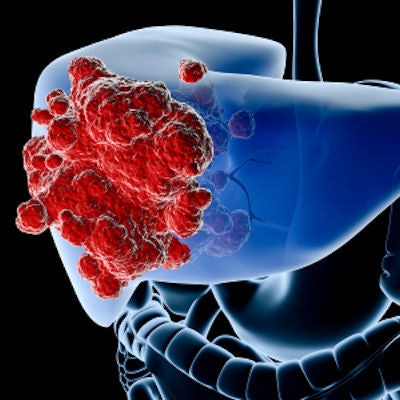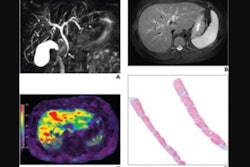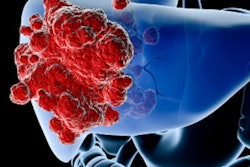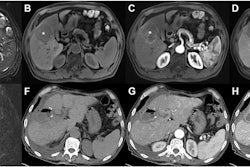
Specific features on multiparametric MRI scans can help predict hepatocellular carcinoma recurrence in patients who have undergone percutaneous microwave ablation for primary cancer, a group of Chinese researchers has found.
The study results -- published August 30 in Cancer Imaging -- could improve the ongoing care of patients treated for liver cancer, wrote a team led by Zhaohe Zhang, PhD, of Chinese PLA General Hospital in Beijing, China.
"There may be a role for dynamic MRI, and imaging results may help select patients with hepatocellular carcinoma who would not perform well after curative ablative therapy and who may be candidates for postoperative supplementary treatment strategies and clinical trials," the group wrote.
Hepatocellular carcinoma is the main form of liver cancer and is the third most common cancer-related cause of death around the world, the authors explained. Liver cancer is often treated with percutaneous microwave ablation -- a treatment that has overall survival rates comparable to surgery in people with early-stage disease.
Even so, early recurrence after ablation does occur, and it is associated with aggressive disease and poorer prognosis, the team noted. The group cited one study that found that up to 70% of patients with hepatocellular carcinoma and cirrhosis experience disease recurrence after undergoing microwave ablation, especially within the first two years after treatment.
But microwave ablation eliminates the possibility of performing a histopathological exam of the whole tumor, and this makes predicting recurrence challenging, the team noted. Risk of recurrence in patients with ambiguous response to ablation is assessed only in the absence of residual tumors at one-month MRI follow-up. Sometimes patients undergo a preoperative biopsy in order to predict prognosis after ablation treatment, but this is often not ideal, as it can be difficult to biopsy tumors that have formed in tricky locations, such as near key vessels.
Imaging findings on MRI can help clinicians understand a tumor's "biological behavior" and thus improve their ability to make an accurate prognosis regarding disease recurrence, the group explained: Features such as ill-defined tumor margins, an absence of a tumor capsule, and enhancement of the area around the tumor the arterial phase may indicate that the cancer is aggressive.
Zhang and colleagues sought to assess any connections between MRI exam features and cancer outcomes after microwave ablation in patients with hepatocellular carcinoma, and to develop a post-ablation treatment algorithm based on multiparametric MRI data.
"Diffusion-weighted imaging is an important MRI functional imaging tool with the unique ability to display microscopic functional information such as the tissue cell structure and cell membrane integrity, and its quantitative parameters can provide information on the status of a lesion after treatment," the authors noted.
The group conducted a study that included 339 patients treated for liver cancer with percutaneous microwave ablation between January 2014 and December 2017. All patients underwent multiparametric MRI. The researchers included the following factors in the algorithm they developed:
- Ill-defined tumor margins
- Lack of tumor capsule enhancement
- Preablative apparent diffusion coefficient (ADC)
- Changes in ADC (ΔADC)
- Exponential ADC
These factors were used to calculate patients' risk of recurrence (a recurrence score was determined using MRI imaging data; a high risk score was equal to or higher than 110).
It's not surprising that the investigators found that higher risk scores were predictive of liver cancer recurrence after ablation (recurrence scoring had a sensitivity of 89% and specificity of 95%); they found that the factors included in the development of the algorithm were predictive of recurrence as well.
But the team also discovered that the combination of minimal ablative margin and tumor size data in the algorithm had high predictive accuracy, sensitivity and specificity.
| Algorithm performance for predicting hepatocellular carcinoma recurrence post-ablation on MRI | |
| Measure | Minimum ablative margin plus tumor size algorithm |
| Positive predictive accuracy | 93.5% |
| Specificity | 92.3% |
| Sensitivity | 83.1% |
The findings suggest that an algorithm based on MRI data could improve the ongoing care of patients treated for primary liver cancer with ablation, according to the team.
"Our study highlights the ability of an image response algorithmic strategy based on preoperative multiphase enhanced MRI to predict the emergence of [recurrence] after microwave ablation of hepatocellular carcinoma with high sensitivity and specificity," the group concluded. "Further multicenter studies with a higher number of patients are needed to validate our findings."




.fFmgij6Hin.png?auto=compress%2Cformat&fit=crop&h=100&q=70&w=100)




.fFmgij6Hin.png?auto=compress%2Cformat&fit=crop&h=167&q=70&w=250)











